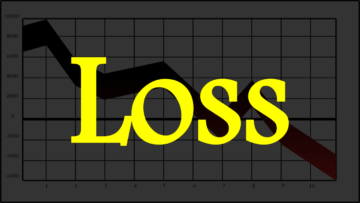In accounting, there are many terms that are used to represent different phenomena/events and one of them is the term loss which is used to represent the shortfall of revenue on expenditure, and it is a common term that we generally hear in business related matters
Loss is the biggest fear for any business as it affects the survival of the business and every business tries to avoid it. To find out the profit or loss in the business, many reports are prepared from time to time which are based on the transactions taking place in the business. Note: The more correctly the transactions taking place in the business are managed, the more accurate the reports prepared will be.

Table of Contents
What is Loss?
Loss is an accounting term that indicates a deficit in revenue over expenditure/expenses. In simple words, when expenditure exceeds income, it is called a loss. Generally, it is calculated through the profit and loss account and if the business is involved in trading, then a trading account is also used.
| Loss = Expenses > Revenue |
| Formula |
| Profit/Loss = Revenue – Expenditure/Expenses or Profit/Loss = Selling Price – Cost Price |
As per accounting principles, loss is mainly classified into three parts such as gross loss, operating loss, and net loss. In detail, gross loss means loss after deducting direct expenses from revenue and it is generally calculated through a trading account, operating loss means loss after deducting operating expenses like indirect expenses (excluding taxes) from revenue/gross loss and net loss means loss after deducting all expenses including taxes from operating loss/revenue.
| Gross Loss | Direct Revenue < Direct Expenses |
| Operating Loss | Revenue/Gross Profit < Indirect Expenses/Operating Expenses (Excluding Taxes) |
| Net Loss | Revenue/Operating Profit/Gross Profit < All Expense (Including Taxes) |
Loss is shown in the liability side of the balance sheet under equity and share (capital), and it decreases the owner’s share as it is subtracted from the owner’s share and similarly, profit is vice versa. Note: Only net loss is shown in the balance sheet.
Features of Loss
Following are the features of the loss:
1. Accounting Term:
The term loss is an accounting term used to denote the amount of shortfall of revenue over expenses. For example, a marker is sold for Rs.200 which was bought for Rs.250, in this case, the revenue is Rs.200 and the expense is Rs.250 and the balance after deducting the expense from the revenue is the revenue shortfall of Rs.50 and this amount of shortfall is called loss.
2. Recorded on the Books:
Loss is recorded in the business books like balance sheet, etc. and it is calculated through trading account, profit and loss account, etc. Gross profit or loss is calculated with the help of trading account and net profit, or loss is calculated with the help of profit and loss account. In the balance sheet, loss is recorded under the owner’s share (capital) on the liability side.
3. Classified:
Loss is classified into various parts but mainly it is classified into three parts: 1. Gross loss, 2. Operating loss, and 3. Net loss and all types of loss have their own meaning. For example, gross loss means loss after deducting direct expenses from revenue, operating loss means loss after deducting operating expenses from revenue/gross loss, and net loss means loss after deducting all expenses including taxes from operating loss/revenue.
4. Decrease Liability:
The loss reduces the liability of the business as the loss is recorded on the liability side of the balance sheet under the heading of equity and share commonly known as capital and is subtracted from the owner’s share. The reason behind recording the loss on the liability side of the balance sheet is the separate legal entity principle/concept. A separate legal entity means that the owner and the organization are two different persons.
5. Uncertainty:
Loss is uncertain in nature as it depends upon the activities of the organization and it is determined by various factors like price, margin, market condition, competition, product availability, demand, supply, etc. But to some extent, the profit and loss ratio can be maintained by using various strategies.
Read Also:
QNA/FAQ
Q1. What is loss?
Ans: Loss is an accounting term that indicates a deficit in revenue over expenditure/expenses.
Q2. Write the formula to calculate the loss.
Ans: Profit/Loss = Revenue – Expenditure/Expenses
Q3. Does a loss reduce the liability of the business?
Ans: Yes, the loss reduces the liability of the business as it is subtracted from the owner’s share.
Q4. On which side is the loss recorded in the balance sheet?
Ans: Liability side
Q5. Write the features of loss.
Ans: Following are the features of the loss:
1. It is an accounting term.
2. It refers to the shortfall of revenue over expenditure.
3. It is recorded in the books.
4. It reduces the liability of the business.
5. It is uncertain in nature.
6. It is classified into various parts.
7. It is the main fear of businesses.
8. It reduces the share of the owners.
9. It is calculated through accounting reports.
10. It is the opposite of profit.













